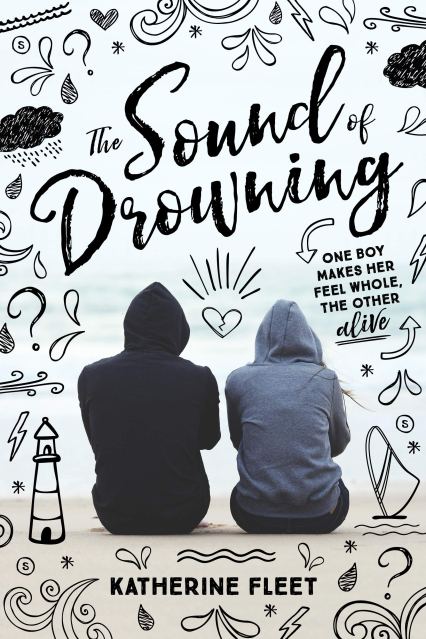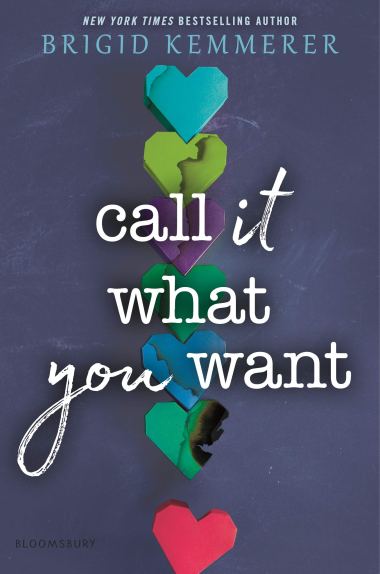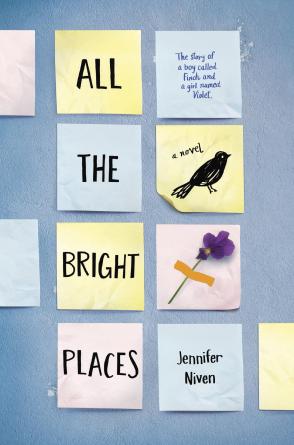
“[The pictures] kept going – a chronicle of our family, and like all families, it deliberately displayed only part of the story. Because that’s what we’re taught to do – to only capture the good times, the smiles, and the happiness. We don’t take pictures of the tears or the fights, the losses and the loneliness, but why not? Why shouldn’t they also be valued and remembered?” (Fleet 2019, p. 228).
To say this book was a roller coaster ride would be a MAJOR understatement. When I first started reading, I was intrigued by the premise, and thought I was going to get a fluffy version of Romeo and Juliet for teens. Very quickly, however, I became intrigued by Mer’s dark secret, and wanted to know what she had done to cause such a rift between two previously close families. What I got was an emotionally devastatingly story about love, loss, and forgiveness that I wasn’t expecting at all. WARNING: There will be spoilers in this review, so please don’t read this if you have any intention of picking up the book!
The Sound of Drowning follows the story of Meredith Hall, a teenager with a big secret: almost every night, she takes the ferry to meet the love of her life, a boy named Ben Collins. Though Ben and Meredith have been best friends since childhood, their relationship has evolved over time from friendship to romance. Recently, however, Meredith broke Ben’s trust in a major way, causing their once close families to fracture apart and forcing them to meet in secret. At the same time, a new and charming boy named Wyatt Quinn has moved with his mom from Texas, and the previously closed-off Meredith finds herself inexplicably drawn to him. Though she was once sure what she wanted, Mer finds herself torn between two people: the boy she has loved for most of her life, and the boy who makes her feel exciting and alive for the first time in her life.
I was not expecting to need tissues while reading this book, and I feel personally attacked by Katherine Fleet. Not since John Green’s The Fault in Our Stars has a YA book impacted me this much emotionally, and I applaud (and curse) Fleet’s ability to get me so entirely emotionally invested in these characters. From the very first chapter, I found myself wondering what Meredith had done to warrant such a severe rift in the relationship between two families, meaning Katherine Fleet had me hooked within a few pages. The novel is paced slowly, intermittently telling the story of Meredith’s past as we read about what’s currently happening. The secret is revealed painfully slowly, making it hard to wait to find out exactly what happened. I’ll admit that, at one point, I couldn’t wait anymore and read ahead, and the fact that the reveal STILL gutted me when I got to it is a testament to Fleet’s writing ability.
First, I have to praise the twists in this book. I was honestly expecting a run-of-the-mill fluffy romance, but this book kept me guessing with every chapter. First, you find out that Mer and Ben had sex and that Mer ended up pregnant. Next, you find out that Mer decided to have an abortion behind Ben’s back, making Ben feel extremely betrayed and hurt. Though the novel’s first chapter leads us to believe that he eventually forgave her and began meeting her in secret, we eventually find out (WARNING: SPOILER AHEAD) that Ben has been dead for several months due to a boating accident, and that Mer began hallucinating him on the beach after trying to kill herself one night in her grief over his loss. As if all of this wasn’t enough, we THEN find out that the present day events Mer has been experiencing are entirely in her head, as she has been in a medically induced coma for the entire book. At the end, she makes the choice to return to the world of the living, where she decides to start over again with Wyatt, who she feels she knows even though they haven’t officially met yet.
This book delivers not one, but FOUR heart-pounding twists in this book, meaning that once I reached the halfway point, this book was impossible to put down. Fleet’s twists honestly surprised me, and the plot never once felt predictable or overdone. In addition, the emotional impact of each reveal is extremely raw, and many moments in this book left me a sobbing mess in need of something light and happy to read. One such moment is the moment when Mer confronts Ben’s parents for the first time since his death, apologizing for the choice that hurt them, but also insisting that it is wrong to blame her (and themselves) for his untimely death. Mer’s words and the strong emotions in this scene had such a profound impact, and they really illustrated her character growth throughout the book.
Another thing I really enjoyed about this book were the relationships between the characters. Not only are the romances sweet and believable (both with Wyatt and with Ben), but the familial relationships were extremely important as well. I felt a strange kinship to Meredith (even though she sometimes frustrated me), as my relationship with my mom is very similar to hers. We obviously love one another, but struggle to understand each other, often feeling as though we’ll never be good enough for the other person. Mer and her mother struggle with this as well, and Mer beats herself up constantly for being a “failure child” to her parents. Other realistic and well-developed relationships include Mer and her sister, Wyatt and his dad, and the friendship between Ben’s mom and Mer’s mom. Every time these characters interacted, I felt like they were real people with real flaws, each of them hiding their pain behind big fronts or masks. I found myself rooting for them despite their flaws, and wanting things to end on a positive note for all of them.
I must admit, however, that I did find a lot of things about this book annoying at first. Weirdly, though I relate strongly to Mer’s feelings of loneliness, isolation, and self doubt, she REALLY got on my nerves for the first half of the book. She’s whiny, selfish, and deliberately sabotages her own happiness constantly. The most frustrating part was her flashback to the middle school dance, where she tears her expensive hairdo down and chucks the expensive dress she got for no apparent reason, leaving her date (Ben) as the only one dressed up for the event. I found myself saying, “Really? All of that money and effort and you just spit on it?” As I read on, however, I realized that Mer acts the way she does because she feels so profoundly uncomfortable in her own skin that she’s constantly trying to be someone else, another thing I strongly relate to. My annoyances with Mer stem from my annoyances with myself, and I found myself really understanding that her “prickly” attitude and thick walls are her only way of emotionally protecting herself from a scary social climate.
Similarly, I felt that Ben’s relationship with Mer was EXTREMELY unhealthy at first, with her basing all of her self worth and happiness on this one boy. By the end, however, you realize that this has been the entire point of the novel: Mer WAS putting too much of her self worth in Ben’s affection, and not giving herself enough love or compassion. When she chooses to let Ben go and live for her family and friends at the end of the book, it seems that Mer has truly learned how to love herself and forgive herself for her mistakes. This is actually a huge theme in the book: both forgiving others and forgiving yourself after tragedy strikes. A large part of the grief process is shown in this book, and I think it could do wonders for anyone trying to heal after a significant and traumatic loss. As someone who has lost loved ones in the past, I found myself really relating to the devastation Mer felt, and I have also wondered how to get up and move on when stricken with impossible grief. This book takes something that seems extremely unhealthy and presents it as such, teaching the reader a lesson about self-worth, compassion, and moving on after loss. It’s an extremely powerful message, and one that I think many people (especially teens) need to hear.
My one gripe with the book is how quickly and neatly everything is wrapped up. In real life, trauma, grief, and mental illness can sometimes take years of therapy to improve, but Mer’s issues seem to be instantly resolved due to her few weeks of experiencing life while in a coma. Almost immediately after waking up, she’s able to go to Ben’s parents and explain that she’s sorry, but not responsible for his death, and that they shouldn’t project their grief and anger onto her. At the same time, she has suddenly realized her self worth and completely healed from her trauma, and seems to be entirely chipper and back to normal again. She even knows exactly what to say to Wyatt’s mom about lying to him about his dad, and this struck me as being a little unrealistic. Real teens suffering from trauma and mental illness might feel bad after seeing how easily Mer is able to overcome it; it seems as though she snaps her finger and instantly becomes better at the end. Real trauma takes time to heal, and those negative thoughts we build up in our heads take more than just a few weeks to train away; I know this from personal experience. Though I liked the hopeful, positive ending, I would’ve liked to see Mer improve while still having work to do in regards to her mental health, which is always evolving as we grow and learn.
This book deals with a lot of themes that might be triggering to teens, but also highly empowering. Divorce, teenage pregnancy, abortion, and even suicide are explored, but in a way that promotes responsibility and dealing with grief in healthy ways. Though I felt a little icky about Ben and his family’s reactions to the abortion (it was, ultimately, Mer’s choice what to do with her body, and I felt that at LEAST the adults should have respected that), I liked that the author gave her the agency to make her own choice, and that the choice itself was something Mer didn’t regret because it was the right one for her. This book isn’t necessarily saying that abortion is the best option, but that each girl and woman should feel empowered to make the decision that is ultimately best for her. It also portrayed suicide in dark, gritty detail, showing the reader the absolutely devastating affects that even attempted suicide can have on loved ones. Mer realizes in the end that, despite her loss, she still has a lot to live for, and I like that message for teens who might feel similarly hopeless about their lives.
Overall, I really enjoyed this book. It has some flaws, but I really appreciated the characters, message, and engaging story. Any book that can make me cry over fictional characters is necessarily a winner, as I don’t often feel profoundly moved when reading YA. Though there are subjects that might be triggering to some teens (grief, abortion, suicide, mental illness), I think this book begins really important conversations that could lead to healing and closure for many. I was very moved by this story, and though I’ve never heard of Katherine Fleet before, she is now very much on my radar due to this stunning work of fiction. If you’re in the mood to read something that will break your heart in all of the best ways, I would definitely recommend giving this one a shot if you haven’t already; it most certainly did not disappoint.
Reference:
Fleet, K. (2019). The sound of drowning. Salem, MA: Page Street Publishing.

